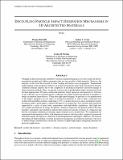Decoupling particle-impact dissipation mechanisms in 3D architected materials
Author(s)
Butruille, Butruille; Crone, Joshua C.; Portela, Carlos M.
DownloadButruilleEtAl2024_PNAS_ImpactArchitectedMater.pdf (62.05Mb)
Open Access Policy
Open Access Policy
Creative Commons Attribution-Noncommercial-Share Alike
Terms of use
Metadata
Show full item recordAbstract
Ultralight architected materials enabled by advanced manufacturing processes have achieved densitynormalized
strength and stiffness properties that are inaccessible to bulk materials. However, the majority of this work has focused on static loading and elastic-wave propagation. Fundamental understanding of the mechanical behavior of architected materials under large-deformation dynamic conditions remains limited, due to the complexity of mechanical responses and shortcomings of characterization methods. Here, we present a microscale suspended-plate impact testing framework for three-dimensional (3D) micro-architected materials, where supersonic microparticles to velocities of up to 850 m/s are accelerated against a substrate-decoupled architected material to quantify its energy dissipation characteristics. Using ultra-high-speed imaging, we perform in situ quantification of the impact energetics on two types of architected materials as well as their constituent nonarchitected monolithic polymer, indicating a 47% or greater increase in mass-normalized energy
dissipation under a given impact condition through use of architecture. Post-mortem characterization, supported by a series of quasi-static experiments and high-fidelity simulations, shed light into two coupled mechanisms of energy dissipation: material compaction and particle-induced fracture. Together, experiments and simulations indicate that architecture-specific resistance to compaction and fracture can explain a difference in dynamic impact response across architectures. We complement our experimental and numerical efforts with dimensional analysis which provides a predictive framework for kinetic-energy absorption as a function of material parameters and impact conditions. We envision that enhanced understanding of energy dissipation mechanisms in architected materials will serve to define design considerations towards the creation of lightweight impact-mitigating materials for protective applications.
Date issued
2024-01-29Department
Massachusetts Institute of Technology. Department of Mechanical EngineeringJournal
PNAS
Publisher
National Academy of Sciences
Citation
Butruille, Butruille, Crone, Joshua C. and Portela, Carlos M. 2024. "Decoupling particle-impact dissipation mechanisms in 3D architected materials." PNAS.
Version: Author's final manuscript
Collections
The following license files are associated with this item: